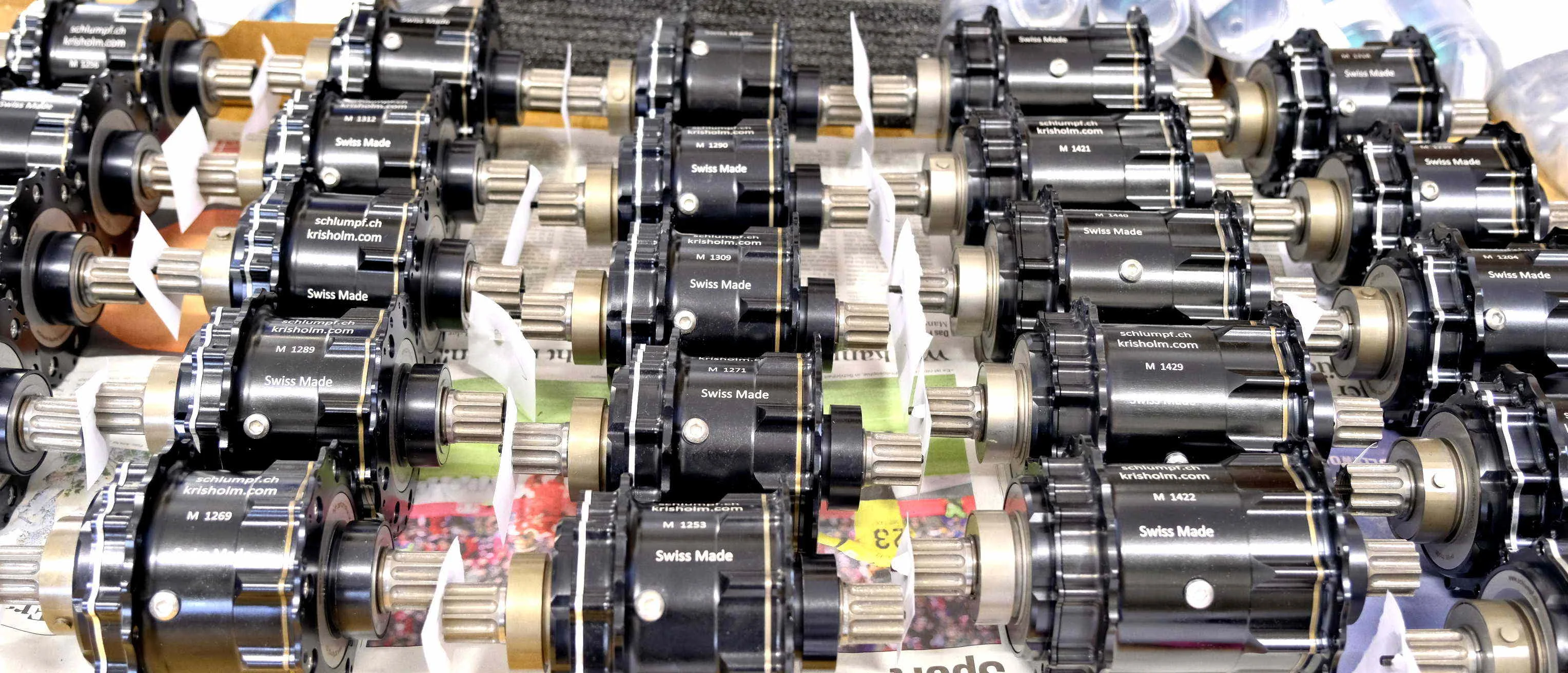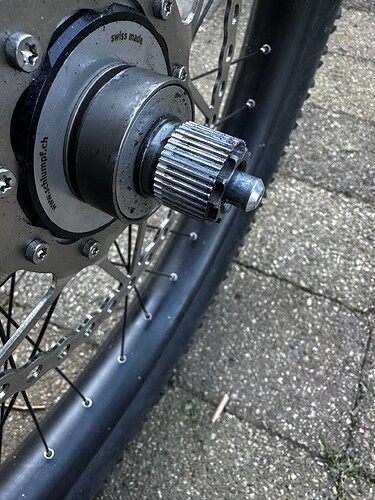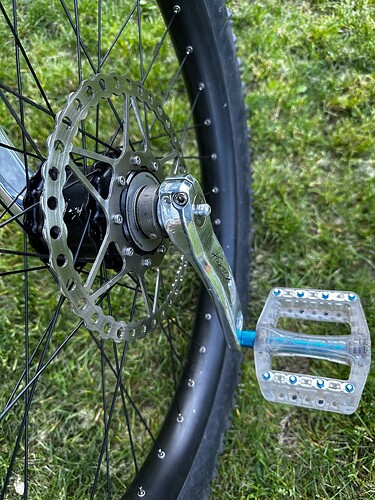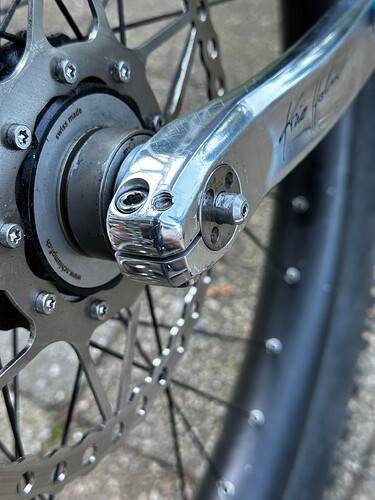What I read is that the more points of engagement, the smaller the pawls have to be to contain the hub dimensions, so the weaker they are. So, yes, such a small number of points of engagement may let them be quite big and durable.
However, I can’t get past the fact that you have to turn your feet 30° to stabilise a coast that turned bad.
By the way, that also mean that if the road to the pass is not perfect, it makes it even harder to climb as you’ll have to often get your balance back. That’s an issue I had with the Nimbus hub when riding uphill in the forest: each obstacle was way more harder to pass than with a fixed wheel. Now that I ride a Pipifax hub, the issue has dramatically decreased in how often it appears.
Right, same concept as current Schlumpf hub
It depends on the technology of the pawls, I can easily imagine Schlumpf’s light design modification to get a freewheel kipping exactly current pawls, probably rather similar to the wear when cranks are loosing and hub having freewheel …
About the possibility to move to a Q-Axle interface. I’m running that setup right now, as is reported elsewhere, using a prototype shim adaptor that is ISIS on the inside and Qu-Axle on the outside. With a different end-bolt and shifter button.
Unfortunately, production cost is really high - not yet sorted out.
While the Q-Axle spline would be better as standard spec, this has the advantage of not requiring a total hub redesign and the ability to fit on existing hubs.
I am really interested in how it works, could you share some drawings or explanations about how it is made ?
haha! swear you don’t want to print it ![]()
I absolutly swear I won’t print it.
First of all, I can’t (even though I might have access to a metal printer), and I don’t want to steal @danger_uni 's work.
I am just genuinly interested in how it works (especially how does it stays in place without moving?)
The shiftknob looks rather small and not rounded. How does this affect shifting? Is this limited by the design of the adapter?
It would be great if KHU would continue the KH Spirit cranks. I think they are just perfect with the Schlumpf hubs. ![]()
Pleeeeeease! ![]()
I have been thinking about this sentence of yours. How much would this cost? Could we imagine some sort of crowdfunding to help the project? I know some of us may spent a lot of money to improve unicycle stuff ![]()
Agreed. Small production run?
I repeat my emailed mention that I’d take a couple of adapter sets - and given I see this as more than just a crank adapter but from what I see perhaps a safer and more solid way to mount them and then shift.
My hub addiction says I’d pay for this ![]()
![]()
Every time I’ve discussed this over the last couple of years I’ve presumed that you’d need to install the adapter into the q-axle crank first (and have it include a stop behind the crank) before then tightening the crank onto the axle as you would normally do with ISIS.
From your pictures it looks like the end-cap is attached to the crank as is standard on q-axle rather than being able to prevent the tapered ISIS interface from sliding off as is normally required with ISIS cranks.
Q-axle also has a flat on the interface that only permits installation of cranks one way around - is this present on your adapter, and if so does that cause additional issues with installation?
Hm, okay, this is a tough one.
After literally spending days lacing and trueing the wheel (and the spoke tension is way more uniform than on my other big unis) and modifying the frame of my GETitONE X-Tour 29 so the hub would fit in it, it was finally time to assemble the various pieces to form a unicycle. That’s what I did roughly two hours ago, only to find out that the hub wouldn’t shift! …anymore. Saying that this is a bummer is a bit of an understatement.
The hub worked after the wheel was laced. I have two possibilities in mind how it got damaged:
- In the trueing process I did stress-relieve the spokes by placing the hub on a circle of a similar diameter to the one of the flanges (the cardboard center of a big roll of tape happened to fit quite nicely) and then pressing onto the rim with both hands. In theory, the shifting rod could touch the ground and maybe that could cause some damage, but I doubt it. First of all, the cardboard was large / high enough for the rod to clear the ground. And even if, there’s plenty of travel beyond the position of gear engagement (when you hear that ´click´), so it’s very improbable for any damage to occur even if the rod went beyond said position.
- Last night I mounted the tube and tire (man, are all tubeless ready tires such a pain to get on a rim?). When finished, I let the wheel drop so it would rebound and I would grab it with my hand. I did this a couple times; it’s kind of a (bad?) habit of mine when I pump wheels that aren’t mounted to a frame.
Number 2 seems more likely to me, even though I didn’t drop it from great height, maybe 30-40cm max, and I catched the wheel after the rebound, so the hub didn’t suffer from a direct hit to anything.
After realising the issue today I repeated the rebound thing in the hopes that this could free some pin or whatever in the hub that may was jammed, but to no avail.
Before I go through the pain of taking that °°![^~+“*” tire off the rim, unlace the wheel and send the hub back to Florian - has anybody here an idea what the problem could be, and what could be done to solve it without disassembling the hub?
Edit, since I forgot to mention it: There is play after the the buttons have been pushed in and engaged the gear.
A quick check: is there any play behind both buttons?
Yes, there is. Forgot to mention that, sorry. That was my first thought, so I unscrewed the buttons and now you can push them like 5mm or more after the click.
Ok, great you’ve already checked that!
Which hub series is it? Which number? Have you used spacers? Have you tried to remove the cranks before shifting?
Number is 12xx, I think 1210. Was assembled this autumn. You mean crank spacers?
![]()
No I completely forgot about them, even though I realised that the cranks wouldn’t touch the bearing protection caps, or what they are called. I just tightened them to 55Nm.
I’m not sure how this would affect the ability to change gears, but I will try to remove the cranks and see if everything works. I wrote “try” because I don’t have a crank removing tool (yet). I usually rely on those self extracting bolts, but will have to see if they work here. Already realised that Florian uses M14 bolts whereas my other uni hubs with ISIS interface usually use M12, and in one case M8.
Yessss! I’m not sure why, but now it works again. ![]()
I couldn’t even remove the crank (didn’t dare to go full force again on that soft bolt), but when i was working on it the gear suddenly changed. And does consistently so, since. I’ve checked every of the 24 positions for a gear change in both directions, and there were no issues.
I can’t quite understand what the problem was in the first place, but I’m looking forward to testing the new wheel tomorrow! ![]()
![]()
Thanks for your quick help, Maxence!
Nice to learn the issue has disappeared!
On some old hubs, I think cranks that has been tighten too much can push the bearings, which can create issues in the mechanism. But I thought this wouldn’t be the case on new hubs ![]()
You should maybe send a mail to Florian, so he is aware of the issue.
Definitely not the case here, since there are those black „pressure discs“ that direct the pressure of the cranks to a clip that sits in a groove in the axle. But since I forgot to install the spacers the cranks don‘t even touch those pressure discs, so the cranks exert no lateral pressure on the bearings at all.
Such a disc can be seen in the following image:

and the clip underneath it can be seen here, if you have a closer look (on the hubs in the two rows on the right side of the image):

NB: I was surprised that my hub has a lower serial number than the ones in this picture, yet it had first to be assembled before Florian could deliver it. Now I think I understand, why; these are 36h hubs, while I wanted a 32h one, for better / wider rim availability. The 36h batch was obviously first assembled, since those hardcore muni riders all want the strongest wheel possible.


